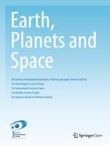After eight years of dedicated work on Earth, Planets and Space, Prof. Yasuo Ogawa will hand over editorship of the journal to Prof Takeshi Sagiya. They spoke to us about the challenges in their research fields, the benefits of OA, and the journal's future plans.
Call for papers: Quantitative Assessment and Modeling of Volcanic Activity
Earth, Planets and Space is calling for submissions to our Collection on "Quantitative Assessment and Modeling of Volcanic Activity".
Featured Article: New aspects of the upper atmospheric disturbances caused by the explosive eruption of the 2022 Hunga Tonga–Hunga Ha’apai volcano
An explosive eruption of the Hunga Tonga–Hunga Ha’apai (Tonga) volcano occurred on 15 January 2022 generated strong shock and air pressure waves in the troposphere. Their influence globally extended from the atmosphere to ionosphere. Shinbori et al. [2023] comprehensively review the characteristics of ionospheric disturbances obtained from ground-based and satellite observation data analyses and summarizes what we know from the Tonga volcanic eruption. Further, this paper shows new scientific results of the magnetic conjugacy of 4-min ionospheric oscillations and the appearance of hectometric line spectra originating from broadcasting waves associated with the occurrence of equatorial plasma bubble after the 2022 Tonga volcanic eruption using SuperDARN HOP radar (https://cicr.isee.nagoya-u.ac.jp/hokkaido/) and Arase satellite (https://www.isas.jaxa.jp/en/missions/spacecraft/current/erg.html) observation data.
Featured Article: Simulation study of atmosphere–ionosphere variations driven by the eruption of Hunga Tonga-Hunga Ha’apai on 15 January 2022
The volcanic eruption of Hunga Tonga-Hunga Ha'apai on 15 January 2022 caused severe disturbances in the atmosphere and the ionosphere. In this event, it is expected that atmospheric compressibility played an important role in the atmosphere-ionosphere disturbances. However, phenomena associated with compressibility of the atmosphere have not been fully investigated. We used an axisymmetric three-dimensional nonhydrostatic atmospheric model and the whole atmosphere-ionosphere model GAIA to study the phenomena related to compressibility. We found that our simulation can elucidate various kinds of disturbances caused by atmospheric compressibility, such as shock waves and acoustic resonant oscillations of the atmosphere and the ionosphere.
An interview with the former and the new Editor-in-Chief
Articles
-
-
Several outstanding issues concerning the ionosphere of Mars
-
Integration of Machine learning and equal differential time method for enhanced hypocenter localization in earthquake early warning systems: application to dense seismic arrays in Taiwan
-
Using radio occultation-based electron density profiles for studying sporadic E layer spatial and temporal characteristics
-
Stable estimation of the Gutenberg–Richter b-values by the b-positive method: a case study of aftershock zones for magnitude-7 class earthquakes
-
Electromagnetic conjugacy of ionospheric disturbances after the 2022 Hunga Tonga-Hunga Ha’apai volcanic eruption as seen in GNSS-TEC and SuperDARN Hokkaido pair of radars observations
-
Extreme geomagnetic activities: a statistical study
-
A study on the predominant period of long-period ground motions in the Kanto Basin, Japan
-
2014 Mount Ontake eruption: characteristics of the phreatic eruption as inferred from aerial observations
-
International Geomagnetic Reference Field: the 12th generation
Recently published Special Issues
Kurile arc subduction zone: View of great earthquake generation and disaster mitigation of related phenomena
Characterization of the geomagnetic field and its dynamic environment using data from space-based magnetometers
Solar-Terrestrial Environment Prediction: Toward the Synergy of Science and Forecasting Operation of Space Weather and Space Climate
Find us on Facebook
Messages on EPS
This video serves as an introduction to Earth, Planets and Space. See also our YouTube channel.
Society affiliation
Aims and scope
EPS publishes in a variety of formats: Full Papers, Express Letters, Frontier Letters, Technical Reports and Comments. In all of these categories, only new and original contents will be considered for publication. Express Letters provide authors with a way to rapidly publish brief reports of high-impact results. Frontier Letters cover frontier research in various fields in Earth and Planetary Sciences, and can be contributed only through an invitation by the Editor-in-Chief. Technical Reports present technical aspects of research in related fields. EPS also provides a venue for topical special issues based on conferences, research projects, and other research initiatives.
The EPS Excellent Paper Award 2023
The following paper won the award:
Chronology of the Chronology of the 2015 eruption of Hakone volcano, Japan: geological background, mechanism of volcanic unrest and disaster mitigation measures during the crisis
Kazutaka Mannen, Yohei Yukutake, George Kikugawa, Masatake Harada, Kazuhiro Itadera and Jun Takenaka
The EPS Young Researcher Award 2023
No recipients
The following papers are awarded for the EPS Special Award:
GEOMAGIA50.v3: 1. general structure and modifications to the archeological and volcanic database
Maxwell C Brown, Fabio Donadini, Monika Korte, Andreas Nilsson, Kimmo Korhonen, Alexandra Lodge, Stacey N Lengyel & Catherine G Constable
GEOMAGIA50.v3: 2. A new paleomagnetic database for lake and marine sediments
Maxwell C Brown, Fabio Donadini, Andreas Nilsson, Sanja Panovska, Ute Frank, Kimmo Korhonen, Maximilian Schuberth, Monika Korte & Catherine Constable
Special Issues accepting submissions
Quantitative Assessment and Modeling of Volcanic Activity
Deadline for submissions: 31 March 2025
New trends in data acquisition, analysis and interpretation of seismicity
Deadline for submissions: 31 August 2024
Evolution and Movement of the Crustal Surface and Application of Geo- and Thermochronology
Deadline for submissions: 31 August 2024
The 2024 M7.6 Noto Peninsula earthquake and seismic swarm
Deadline for submissions: 30 September 2024
Reviewers thank you
Proposals for Special Issues
Earth, Planets and Space welcomes proposals for new special issues on focused topics within the scope of the journal. Click here for more information on how to submit a proposal.
Annual Journal Metrics
-
Citation Impact 2023
Journal Impact Factor: 3.0
5-year Journal Impact Factor: 2.9
Source Normalized Impact per Paper (SNIP): 1.452
SCImago Journal Rank (SJR): 0.919Speed 2023
Submission to first editorial decision (median days): 14
Submission to acceptance (median days): 162Usage 2023
Downloads: 1,455,156
Altmetric mentions: 2,255
Follow
- ISSN: 1880-5981 (electronic)
Information
EPS recognizes awards for excellent papers, authors and reviewers:
- EPS Excellent Paper Award
- EPS Young Researcher Award
- EPS Special Award
- Excellent Reviewers
- Highlighted Papers
Most cited papers:
